PX10 frame dimensions ( mid-70's )
#1
Junior Member
Thread Starter
PX10 frame dimensions ( mid-70's )
I have been looking on and off for a PX10 from the mid-70's ( with decal scheme example as in photo below ) for maybe 10 years and have pretty much given up due to never seeing a frame that is sized suitably for me. I have seen a few dozen bikes or frames advertised on-line in this time.
My size is a 54 cm ( C-C ) seat tube frame but whenever I see any PX10's in this size, I always seem to see an accompanying top tube length of 57 cm, which is just too long for me. Especially when I see the usual 120 mm stem lengths.
That effective top tube length combination ( 57 cm + 12 cm ) is way too long for me.
So I have concluded that the common ( 54 ) frame size combination for this model is 54 S.T. / 57 T.T. ( both C-C ).
Was this "long top tube" sizing a feature of the PX10 ?
I manage very well on a "square frame" i.e. 54/54 ( with a short stem length e.g. 6 cm ), as found on a mid-80's Peug. Aneto.
I could not comfortably ride 54/57, even with the short 6 cm stem.
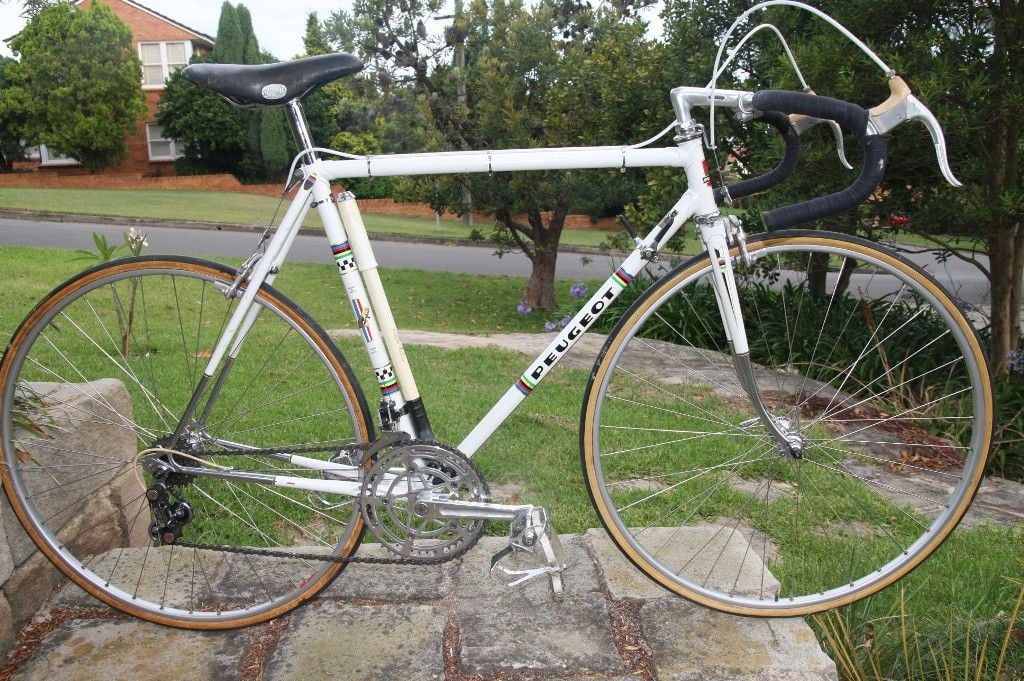
My size is a 54 cm ( C-C ) seat tube frame but whenever I see any PX10's in this size, I always seem to see an accompanying top tube length of 57 cm, which is just too long for me. Especially when I see the usual 120 mm stem lengths.
That effective top tube length combination ( 57 cm + 12 cm ) is way too long for me.
So I have concluded that the common ( 54 ) frame size combination for this model is 54 S.T. / 57 T.T. ( both C-C ).
Was this "long top tube" sizing a feature of the PX10 ?
I manage very well on a "square frame" i.e. 54/54 ( with a short stem length e.g. 6 cm ), as found on a mid-80's Peug. Aneto.
I could not comfortably ride 54/57, even with the short 6 cm stem.

Last edited by redshift1; 01-18-24 at 04:17 AM. Reason: Added Aneto frame dimensions.
#2
Shifting is fun!
Join Date: Aug 2009
Location: South Holland, NL
Posts: 11,006
Bikes: Yes, please.
Mentioned: 280 Post(s)
Tagged: 0 Thread(s)
Quoted: 2198 Post(s)
Liked 4,602 Times
in
1,764 Posts
It seems that various manufacturers used the same standard TT length for all sizes in those days. Raleigh also comes to mind.
This site may be of interest, if you like geometry data: Geometry Geeks
This site may be of interest, if you like geometry data: Geometry Geeks
#3
Senior Member
Join Date: Jun 2021
Posts: 1,683
Bikes: '38 Schwinn New World, ’69 Peugeot PX-10, '72 Peugeot PX-10, ‘7? Valgan, '78 Raleigh Comp GS, ’79 Holdsworth Pro, ’80 Peugeot TH-8 tandem, '87 Trek 400T, ‘7? Raleigh Sports, ‘7? Raleigh Superbe, ‘6? Hercules
Mentioned: 16 Post(s)
Tagged: 0 Thread(s)
Quoted: 761 Post(s)
Liked 1,563 Times
in
757 Posts
I'd always heard that 60s & 70s Pugs used (more or less) the same length TT for all sizes. I've got two '72 PX-10 frames, a 58cm and a 62cm and just took a quick measurement of the TTs, c-c. Like I said, 'quick', and probably not exact, but it seems like the 58cm frame TT measures 58 and the 62cm measures 59. They're in an awkward place in the 'laboratory', and a bit hard to accurately measure, but I'm concluding that they're actually the same length.
Likes For ehcoplex:
#4
Senior Member
Join Date: Aug 2015
Posts: 3,305
Mentioned: 39 Post(s)
Tagged: 0 Thread(s)
Quoted: 1143 Post(s)
Liked 1,749 Times
in
965 Posts
That setup does not look comfortable. You have the saddle all the was back on the rails, and a very long stem. I would be surprised if that bike came with that stem. For starters, I would move your saddle forward drastically, like a half inch. A stem of about 80mm would be a better positioning. But only do one change at a time.
#5
Senior Member
Join Date: Jun 2021
Posts: 1,683
Bikes: '38 Schwinn New World, ’69 Peugeot PX-10, '72 Peugeot PX-10, ‘7? Valgan, '78 Raleigh Comp GS, ’79 Holdsworth Pro, ’80 Peugeot TH-8 tandem, '87 Trek 400T, ‘7? Raleigh Sports, ‘7? Raleigh Superbe, ‘6? Hercules
Mentioned: 16 Post(s)
Tagged: 0 Thread(s)
Quoted: 761 Post(s)
Liked 1,563 Times
in
757 Posts
That setup does not look comfortable. You have the saddle all the was back on the rails, and a very long stem. I would be surprised if that bike came with that stem. For starters, I would move your saddle forward drastically, like a half inch. A stem of about 80mm would be a better positioning. But only do one change at a time.
#6
Junior Member
Thread Starter
#7
feros ferio
Join Date: Jul 2000
Location: www.ci.encinitas.ca.us
Posts: 21,799
Bikes: 1959 Capo Modell Campagnolo; 1960 Capo Sieger (2); 1962 Carlton Franco Suisse; 1970 Peugeot UO-8; 1982 Bianchi Campione d'Italia; 1988 Schwinn Project KOM-10;
Mentioned: 44 Post(s)
Tagged: 0 Thread(s)
Quoted: 1393 Post(s)
Liked 1,329 Times
in
837 Posts
I'd always heard that 60s & 70s Pugs used (more or less) the same length TT for all sizes. I've got two '72 PX-10 frames, a 58cm and a 62cm and just took a quick measurement of the TTs, c-c. Like I said, 'quick', and probably not exact, but it seems like the 58cm frame TT measures 58 and the 62cm measures 59. They're in an awkward place in the 'laboratory', and a bit hard to accurately measure, but I'm concluding that they're actually the same length.
__________________
"Far and away the best prize that life offers is the chance to work hard at work worth doing." --Theodore Roosevelt
Capo: 1959 Modell Campagnolo, S/N 40324; 1960 Sieger (2), S/N 42624, 42597
Carlton: 1962 Franco Suisse, S/N K7911
Peugeot: 1970 UO-8, S/N 0010468
Bianchi: 1982 Campione d'Italia, S/N 1.M9914
Schwinn: 1988 Project KOM-10, S/N F804069
"Far and away the best prize that life offers is the chance to work hard at work worth doing." --Theodore Roosevelt
Capo: 1959 Modell Campagnolo, S/N 40324; 1960 Sieger (2), S/N 42624, 42597
Carlton: 1962 Franco Suisse, S/N K7911
Peugeot: 1970 UO-8, S/N 0010468
Bianchi: 1982 Campione d'Italia, S/N 1.M9914
Schwinn: 1988 Project KOM-10, S/N F804069
#8
Full Member
Join Date: Jul 2018
Location: WNY
Posts: 444
Mentioned: 12 Post(s)
Tagged: 0 Thread(s)
Quoted: 177 Post(s)
Liked 313 Times
in
162 Posts
I have measured two 1972 PX10's and the top tubes were different lengths:
57 cm seat tube - 57 cm top tube
62 cm seat tube - 60 cm top tube
(all center-to-center)
The decal scheme you posted was used in 1977 and 78, which is after the PX-10 frame geometry was changed with steeper seat tube and head tube angles, so the earlier practice re: top tube length may have changed.
57 cm seat tube - 57 cm top tube
62 cm seat tube - 60 cm top tube
(all center-to-center)
The decal scheme you posted was used in 1977 and 78, which is after the PX-10 frame geometry was changed with steeper seat tube and head tube angles, so the earlier practice re: top tube length may have changed.
__________________
72+76 Super Course, 74 P-10+ 79 Tandem Paramounts, 84 Raleigh Alyeska, 84 Voyageur SP, 85 Miyata Sport 10 mixte and a queue
72+76 Super Course, 74 P-10+ 79 Tandem Paramounts, 84 Raleigh Alyeska, 84 Voyageur SP, 85 Miyata Sport 10 mixte and a queue
Likes For Schreck83:
#9
Ride, Wrench, Swap, Race
Join Date: Jan 2010
Location: Northern California
Posts: 9,194
Bikes: Cheltenham-Pedersen racer, Boulder F/S Paris-Roubaix, Varsity racer, '52 Christophe, '62 Continental, '92 Merckx, '75 Limongi, '76 Presto, '72 Gitane SC, '71 Schwinn SS, etc.
Mentioned: 132 Post(s)
Tagged: 0 Thread(s)
Quoted: 1565 Post(s)
Liked 1,296 Times
in
866 Posts
The pictured bike looks like a PX10LE, which I believe went into production alongside a revised PX10E in 1973. Both models had similar geometry.
I have a couple of PX10's from that mid-70's era and the 56cm frame (as I measured the frame size) has a 56cm (Edited, 57cm) top tube.
My 60cm example has a much longer top tube.
I don't know what the 54cm frames had, but I might expect it would at least be somewhat shorter than 56cm (er, 57cm).
These Thevenet-era bikes had radically-steep frame angles, not that such geometry hadn't been tried on French production bikes decades earlier (it had).
With 75+ degree frame angles, these bike's frames are aimed at the needs of professional cyclists, who are very thin, very flexible, and who highly prioritize racing speed over relaxation and comfort.
As such, the rider is positioned rather far forward of the bottom bracket, in a more-aerodynamic position, and where pedaling intensity forces easily mitigate the additional balancing force on the rider's hands caused by the rider's mass positioned ahead of the bottom bracket. The relatively forward saddle position tilts the rider's lower body to a more-forward angle, lessening the bend angle at the waist that would otherwise result from the generous reach (forward and down) to the bars.
For anyone that buys one of these bikes, know that it might only work well for use on shorter, more-intense rides, where sufficient pedaling torque can be maintained and where the added force on the rider's hands might be sustainable for that shorter length of time. And that optimistic scenario asssumes that the rider doesn't have a lot of upper-body weight, and is both flexible and fit.
Using a shorter stem to reduce the reach will upset the intended weight distribution, making the steering uncomfortably light and hyper-responsive.
Using a longer stem makes sense not only because of the weight distribution, but because the racing position tilts the entire body forward, also downward in front, meaning that a shorter/smaller frame can be used without the rider feeling too much drop from the saddle to the bars.
For better and for worse (restating what I've just said), these bikes simply are very much a "go fast or go home" kind of ride!
I have a couple of PX10's from that mid-70's era and the 56cm frame (as I measured the frame size) has a 56cm (Edited, 57cm) top tube.
My 60cm example has a much longer top tube.
I don't know what the 54cm frames had, but I might expect it would at least be somewhat shorter than 56cm (er, 57cm).
These Thevenet-era bikes had radically-steep frame angles, not that such geometry hadn't been tried on French production bikes decades earlier (it had).
With 75+ degree frame angles, these bike's frames are aimed at the needs of professional cyclists, who are very thin, very flexible, and who highly prioritize racing speed over relaxation and comfort.
As such, the rider is positioned rather far forward of the bottom bracket, in a more-aerodynamic position, and where pedaling intensity forces easily mitigate the additional balancing force on the rider's hands caused by the rider's mass positioned ahead of the bottom bracket. The relatively forward saddle position tilts the rider's lower body to a more-forward angle, lessening the bend angle at the waist that would otherwise result from the generous reach (forward and down) to the bars.
For anyone that buys one of these bikes, know that it might only work well for use on shorter, more-intense rides, where sufficient pedaling torque can be maintained and where the added force on the rider's hands might be sustainable for that shorter length of time. And that optimistic scenario asssumes that the rider doesn't have a lot of upper-body weight, and is both flexible and fit.
Using a shorter stem to reduce the reach will upset the intended weight distribution, making the steering uncomfortably light and hyper-responsive.
Using a longer stem makes sense not only because of the weight distribution, but because the racing position tilts the entire body forward, also downward in front, meaning that a shorter/smaller frame can be used without the rider feeling too much drop from the saddle to the bars.
For better and for worse (restating what I've just said), these bikes simply are very much a "go fast or go home" kind of ride!
Last edited by dddd; 03-11-24 at 11:59 PM.
#10
Junior Member
Thread Starter
Thanks everyone for your input and for measuring top tube lengths for me.
Great analysis "dddd" !
I guess it's far better to be comfortable on a nice bike than uncomfortable on your grail bike.
Great analysis "dddd" !
I guess it's far better to be comfortable on a nice bike than uncomfortable on your grail bike.
#11
Senior Member
Join Date: Jun 2021
Posts: 1,683
Bikes: '38 Schwinn New World, ’69 Peugeot PX-10, '72 Peugeot PX-10, ‘7? Valgan, '78 Raleigh Comp GS, ’79 Holdsworth Pro, ’80 Peugeot TH-8 tandem, '87 Trek 400T, ‘7? Raleigh Sports, ‘7? Raleigh Superbe, ‘6? Hercules
Mentioned: 16 Post(s)
Tagged: 0 Thread(s)
Quoted: 761 Post(s)
Liked 1,563 Times
in
757 Posts
'72 and earlier PX-10s have more relaxed geometry and not-radically different graphics/look. Good tire clearance at 700c (even better if you go 650b, which they lend themselves nicely to). I love my '72 and feel like I can ride all day on it.
#12
Full Member
Join Date: Apr 2018
Location: Hitsville USA
Posts: 261
Bikes: 50s, 60s, 70s Nottingham/Worksop bikes, becanes, Gitane, Bertin, Lion of Sochaux
Mentioned: 6 Post(s)
Tagged: 0 Thread(s)
Quoted: 145 Post(s)
Liked 120 Times
in
75 Posts
I have a px10 of this exact color way and decal set , I think perhaps 1976. Seat tube is ctt 21” (53.34) and top tube is 22” ctc (55.88). I think with a very short stem (45mm) this could work for you not withstanding what dddd said about ideal weight distribution for this frame geometry.
Last edited by Slowride79; 01-19-24 at 04:46 PM.
#13
Ride, Wrench, Swap, Race
Join Date: Jan 2010
Location: Northern California
Posts: 9,194
Bikes: Cheltenham-Pedersen racer, Boulder F/S Paris-Roubaix, Varsity racer, '52 Christophe, '62 Continental, '92 Merckx, '75 Limongi, '76 Presto, '72 Gitane SC, '71 Schwinn SS, etc.
Mentioned: 132 Post(s)
Tagged: 0 Thread(s)
Quoted: 1565 Post(s)
Liked 1,296 Times
in
866 Posts
I believe that the suitability of the frame geometry will depend on yet more variables, such as a longer torso/arms proportion perhaps(?).
That is the opposite of my own proportions, yet I have done quite a few rides on a larger-framed one with a modest 10cm stem and ~forward saddle somewhat moderating the reach.
I remind myself though only to use this bike for rides where I might want to be taxing my output limits for a limited amount of time, such as when a fast tandem might be attending one of our 25-mile club rides, when one has to literally ride at their limits to hold that tandem's wheel, on the verge of cramping just waiting for the next recovery stop.
I briefly joined and jousted with a passing fast racer's training paceline on my ride to one such club ride, and one of the riders in this younger group commented that it was "great' or "refreshing" to see one of these vintage racing bikes being ridden the way it was meant to be ridden, man he had no idea (I was fully at my limit for that short period of minutes including one or two decently-long pulls)!

Photos showing the 1973 PX10E having the new geometry, but having returned with the former Nervex Pro lugset.
The Holdsworth "reference frame" has 73x73 frame angles, and you can easily see (helped by the camera's parallax angle) the difference in how the post-1972 Peugeot geometry moves the saddle forward and extends the forward reach (the Holdsworth actually has the same 57cm long top tube as this 56cm 1973/74 PX10E).


That is the opposite of my own proportions, yet I have done quite a few rides on a larger-framed one with a modest 10cm stem and ~forward saddle somewhat moderating the reach.
I remind myself though only to use this bike for rides where I might want to be taxing my output limits for a limited amount of time, such as when a fast tandem might be attending one of our 25-mile club rides, when one has to literally ride at their limits to hold that tandem's wheel, on the verge of cramping just waiting for the next recovery stop.
I briefly joined and jousted with a passing fast racer's training paceline on my ride to one such club ride, and one of the riders in this younger group commented that it was "great' or "refreshing" to see one of these vintage racing bikes being ridden the way it was meant to be ridden, man he had no idea (I was fully at my limit for that short period of minutes including one or two decently-long pulls)!

Photos showing the 1973 PX10E having the new geometry, but having returned with the former Nervex Pro lugset.
The Holdsworth "reference frame" has 73x73 frame angles, and you can easily see (helped by the camera's parallax angle) the difference in how the post-1972 Peugeot geometry moves the saddle forward and extends the forward reach (the Holdsworth actually has the same 57cm long top tube as this 56cm 1973/74 PX10E).


Last edited by dddd; 03-12-24 at 12:06 AM.
Likes For dddd:
#14
Friendship is Magic
Join Date: Nov 2010
Location: Sacramento, CA
Posts: 22,985
Bikes: old ones
Mentioned: 304 Post(s)
Tagged: 0 Thread(s)
Quoted: 26425 Post(s)
Liked 10,381 Times
in
7,209 Posts
.
...I guess it depends on whether you are stuck on that graphics package, but I have had a number of these PX-10's here over the years, and they do vary quite a bit on geometry. This one is pretty comfortable for me, but as you can see it's a larger bike. Maybe a 59cm ?
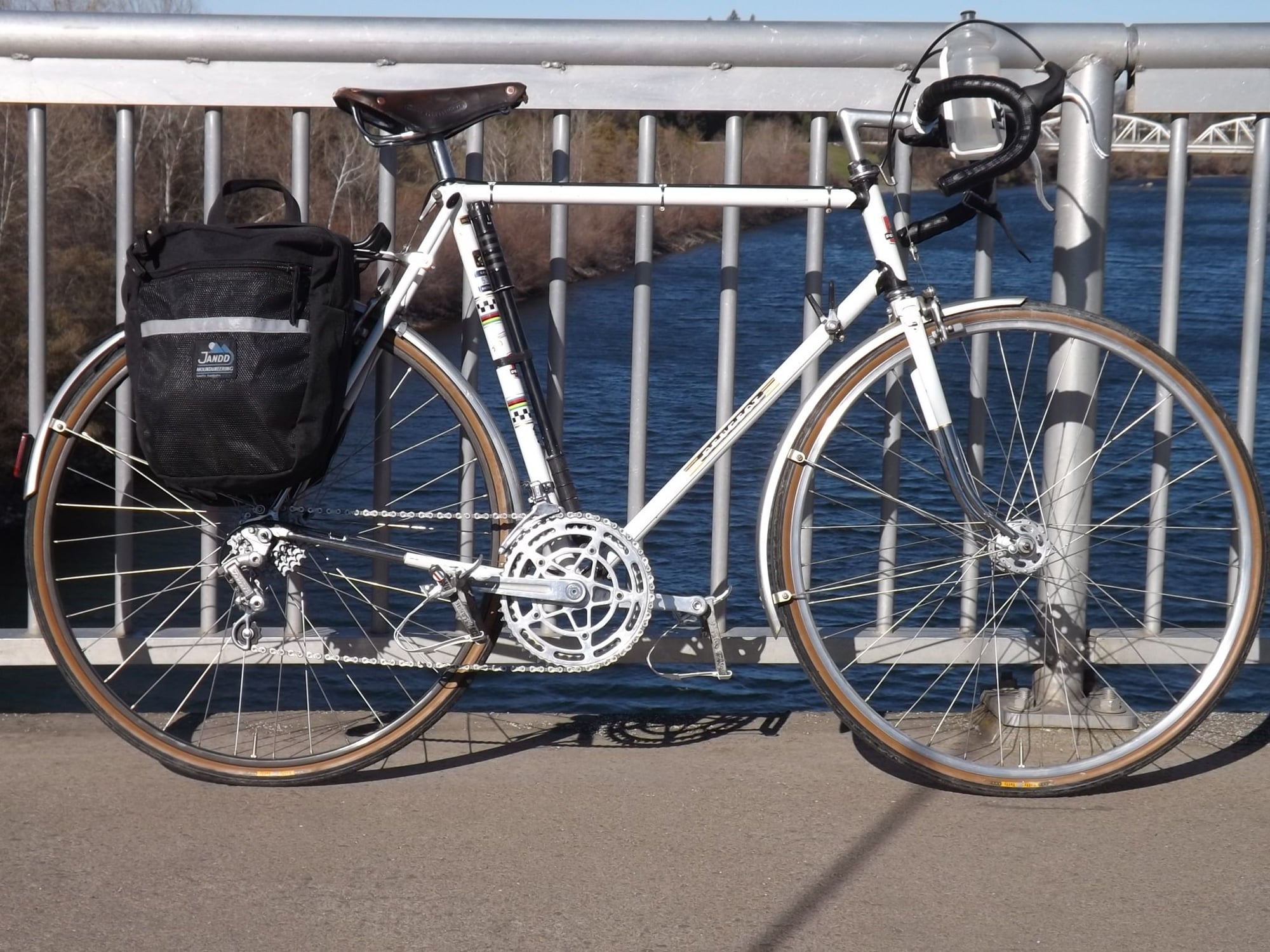
Based on personal experience with them, they got a lot tighter and might fit your preferences better in the late 70's and early 80's.
Those are much 'quicker" bikes, in terms of handling. With the possible exception of the really steep Nervex lugged frames you see sometimes like this one.
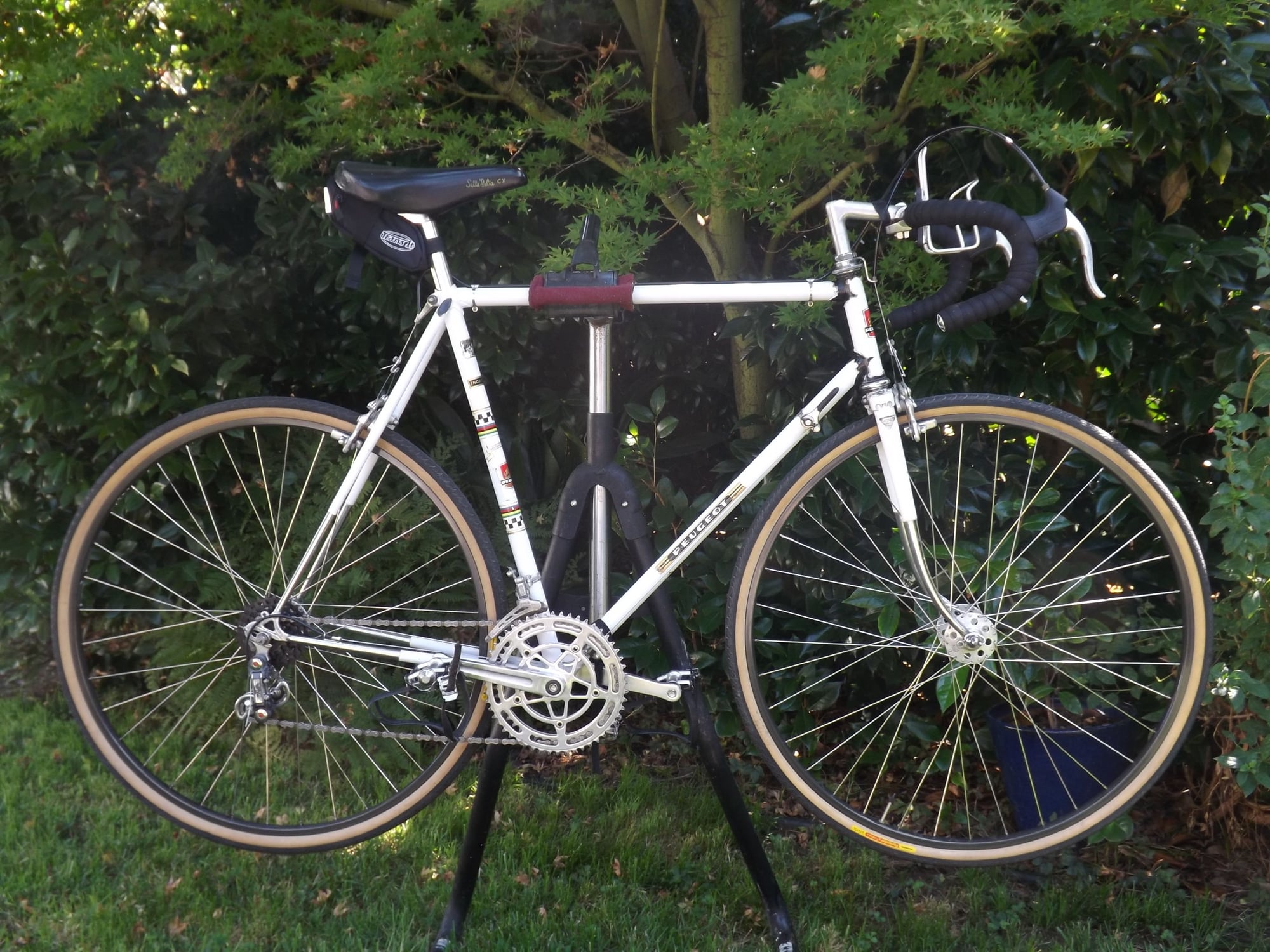
(No, it's not bent. But it does have 27" wheels and a steep head tube.)
But compare those to some of the more colorful, later PX10 LE (and other various alphabetical variations over the ensuing years.) Shorter, tighter, squarer, and more nimble...but somewhat less steady on something like the Paris-Roubaix course roads.

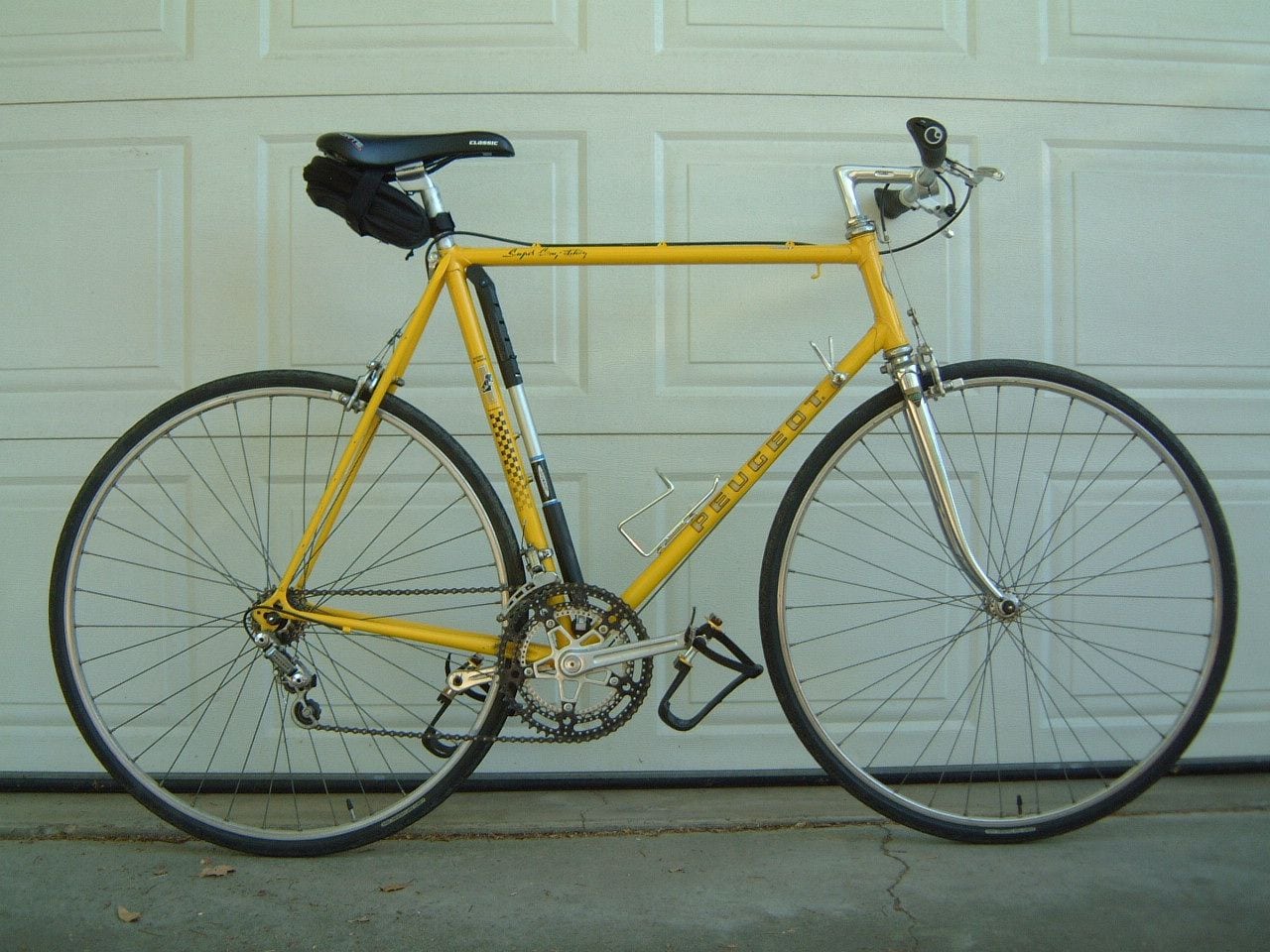
I haven't measured any of these. They are all about 58 or 59cm frames, so it wouldn't help answer your question. But in terms of how they ride and handle, I think maybe what wouild make you happier is something from later in the history of production, like early 80's. But the paint and graphics changed a lot by then.
...I guess it depends on whether you are stuck on that graphics package, but I have had a number of these PX-10's here over the years, and they do vary quite a bit on geometry. This one is pretty comfortable for me, but as you can see it's a larger bike. Maybe a 59cm ?

Based on personal experience with them, they got a lot tighter and might fit your preferences better in the late 70's and early 80's.
Those are much 'quicker" bikes, in terms of handling. With the possible exception of the really steep Nervex lugged frames you see sometimes like this one.

(No, it's not bent. But it does have 27" wheels and a steep head tube.)
But compare those to some of the more colorful, later PX10 LE (and other various alphabetical variations over the ensuing years.) Shorter, tighter, squarer, and more nimble...but somewhat less steady on something like the Paris-Roubaix course roads.


I haven't measured any of these. They are all about 58 or 59cm frames, so it wouldn't help answer your question. But in terms of how they ride and handle, I think maybe what wouild make you happier is something from later in the history of production, like early 80's. But the paint and graphics changed a lot by then.
__________________
Likes For 3alarmer:
#15
Ride, Wrench, Swap, Race
Join Date: Jan 2010
Location: Northern California
Posts: 9,194
Bikes: Cheltenham-Pedersen racer, Boulder F/S Paris-Roubaix, Varsity racer, '52 Christophe, '62 Continental, '92 Merckx, '75 Limongi, '76 Presto, '72 Gitane SC, '71 Schwinn SS, etc.
Mentioned: 132 Post(s)
Tagged: 0 Thread(s)
Quoted: 1565 Post(s)
Liked 1,296 Times
in
866 Posts
By 1979, the PX10 Super Competition model as well as the lower-tier PH501 and so on had been given a contemporary geometry around 74x73.5 degrees in the 57cm size, roughly in between the pre-'73 and post-'72 models. These bikes are lively, but don't so much call attention to their geometry numbers.

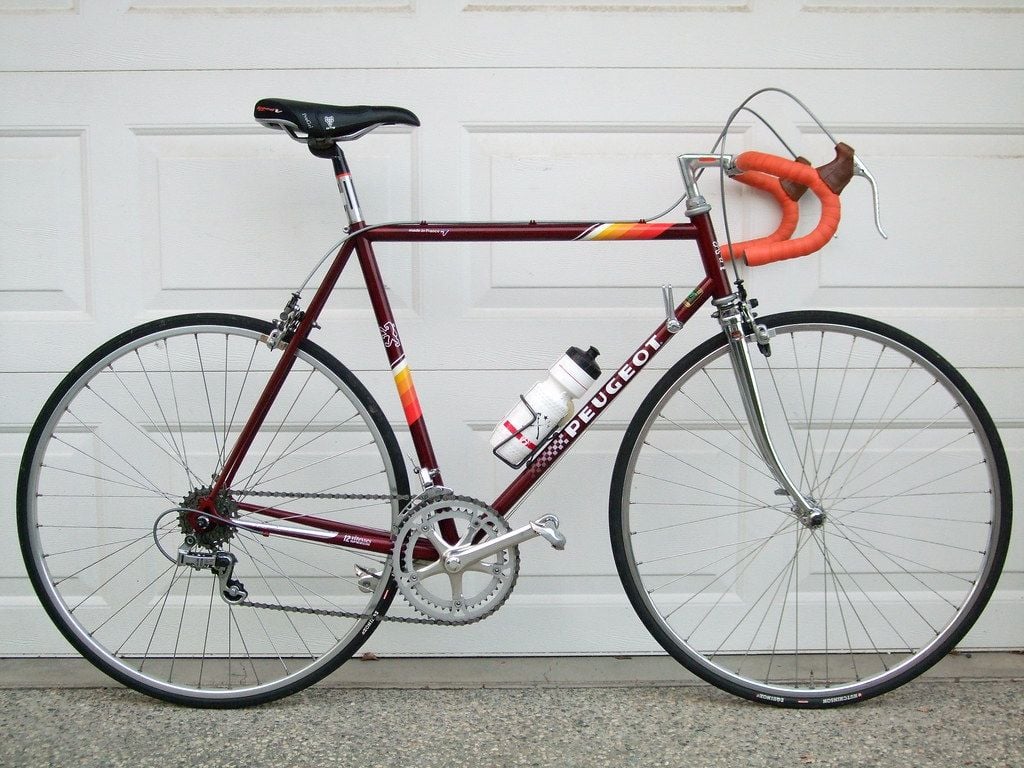


Likes For dddd:
#16
Paramount Fan
Join Date: Dec 2006
Location: Vermont
Posts: 293
Bikes: Paramounts, Raleigh Pros, Colnago, DeRosa, Gios, Masis, Pinarello, R. Sachs, Look, D. Moulton, Witcomb, Motobecane, Bianchis, Fat City, Frejus, Follis, Waterford, Litespeed, d'Autremont, others, mostly '70s-'80s
Mentioned: 3 Post(s)
Tagged: 0 Thread(s)
Quoted: 123 Post(s)
Liked 240 Times
in
133 Posts
Here's my '74 PX10E. I think the geometry was the same as the LE, but I don't see that I recorded the measurements. '74 might have been the first year they brought a size below 21" into the US. This one is a 20" (51 cm) and has a 55 cm top tube as I recall. With the stock stem and long-reach handlebars, I'm pretty stretched out on it. I don't how Peugeot measured their frames and mine is a bit hard to get to right now, so I'm going from memory. I have not found it to be an uncomfortable ride at all. It has pretty long stays and, with the longish top tube, it ends up with a generous wheelbase in spite of the steeper angles.
Long top tubes seemed to be a thing before the mid-1970s, especially in smaller frames, until people started paying more attention to fit. It's hard to imagine the thinking (or lack thereof) that went into top frames with a 54 cm seat tube and a 57 cm top tube, but I've seen exactly that. In some cases it appears the designers were seeking to insure toe clip clearance, but there are more effective ways of doing that, if one really deems it necessary, than making it impossible to get a good rider fit.
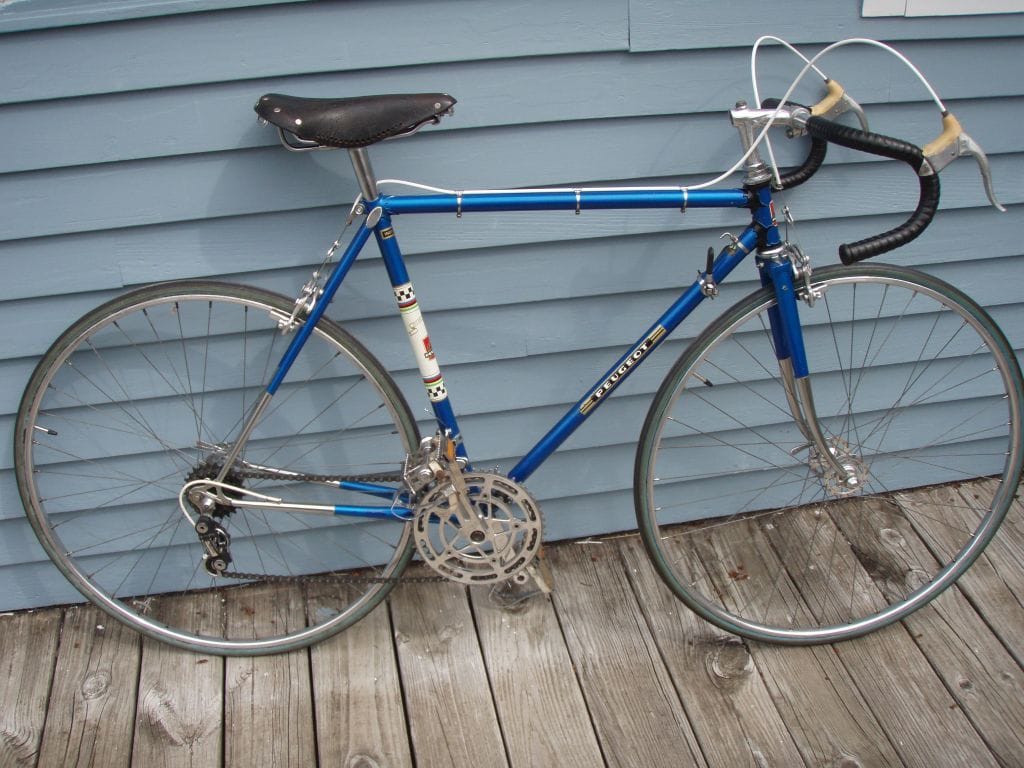
Long top tubes seemed to be a thing before the mid-1970s, especially in smaller frames, until people started paying more attention to fit. It's hard to imagine the thinking (or lack thereof) that went into top frames with a 54 cm seat tube and a 57 cm top tube, but I've seen exactly that. In some cases it appears the designers were seeking to insure toe clip clearance, but there are more effective ways of doing that, if one really deems it necessary, than making it impossible to get a good rider fit.

Likes For sbarner:
#17
Junior Member
Join Date: Dec 2010
Location: Wine Country
Posts: 75
Bikes: 1973 Mercier 300, 1974 Peugeot PX10L, 1975 Lejeune Champion du Monde, 1982 Peugeot PX 10 Super Competition, 1984 Motobecane SP, 1987 Peugeot PX10 "Tout Mavic," 1983 Basso Gap
Mentioned: 0 Post(s)
Tagged: 0 Thread(s)
Quoted: 19 Post(s)
Likes: 0
Liked 9 Times
in
6 Posts
I can confirm that I have recently acquired a 1974 PX10L (same as LE in US) that measures 54x57 c-c. It seems to me unlikely that Peugeot used a constant-length top tube for frames of different heights, as some have suggested; much more likely that they simply made proportionately longer frames for a period of time, which coincides with the appearance of the unusually steep head angles and shallower fork rake. Peugeot stated at the time the this bike (at least the L/LE version) was identical to the team bikes, and It is not hard to see that a reach suitable for a pro rider might seem too long for a recreational rider. It does not seem probable that a company like Peugeot, the largest maker of racing bikes and sponsor of history's most successful pro teams (even now) would be as indifferent to frame design as some above suggest.
BTW, can anyone here confirm that they have a 54 (c-c) PX10 from this same period that has a more normal-length top tube (around 55 cm)?
BTW, can anyone here confirm that they have a 54 (c-c) PX10 from this same period that has a more normal-length top tube (around 55 cm)?
Last edited by mikestr; 03-12-24 at 02:15 PM.
#18
Ride, Wrench, Swap, Race
Join Date: Jan 2010
Location: Northern California
Posts: 9,194
Bikes: Cheltenham-Pedersen racer, Boulder F/S Paris-Roubaix, Varsity racer, '52 Christophe, '62 Continental, '92 Merckx, '75 Limongi, '76 Presto, '72 Gitane SC, '71 Schwinn SS, etc.
Mentioned: 132 Post(s)
Tagged: 0 Thread(s)
Quoted: 1565 Post(s)
Liked 1,296 Times
in
866 Posts
I can confirm that I have recently acquired a 1974 PX10L (same as LX in US) that measures 54x57 c-c. It seems to me unlikely that Peugeot used a constant-length top tube for frames of different heights, as some have suggested; much more likely that they simply made proportionately longer frames for a period of time, which coincides with the appearance of the unusually steep head angles and shallower fork rake. Peugeot stated at the time the this bike (at least the L/LX version) was identical to the team bikes, and It is not hard to see that a reach suitable for a pro rider might seem too long for a recreational rider. It does not seem probable that a company like Peugeot, the largest maker of racing bikes and sponsor of history's most successful pro teams (even now) would be as indifferent to frame design as some above suggest.
BTW, can anyone here confirm that they have a 54 (c-c) PX10 from this same period that has a more normal-length top tube (around 55 cm)?
BTW, can anyone here confirm that they have a 54 (c-c) PX10 from this same period that has a more normal-length top tube (around 55 cm)?
Since a 75+ degree head tube angle combined with an appropriately less-raked fork can steal a couple of cm from the frame's "front-center" dimension, even frames also having a fairly steep seat tube angle may need a minimum of perhaps 57cm of top tube length to prevent dangerously-short front center length if the head tube angle is very steep.
Larger frames can use more of a range of top tube length (typically increasing proportionally with frame size), so the top tube length tends to be more normal even if a steep HT angle is used.
The steep head tube angle keeps the front-center from being too large (for best drafting effect without touching tires), but is usually not so much part of the design of smaller frames since it forces use of a longer top tube and/or steeper seat tube angle, and thus shorter stem, to fit the rider (a combination that may make for twitchy steering response).
I can confirm that the PX10LE's top tube length is much longer in the larger frame sizes, my 60cm example having a 58.5cm top tube.
Last edited by dddd; 03-10-24 at 10:15 PM.
Likes For dddd:
#19
Junior Member
Join Date: Dec 2010
Location: Wine Country
Posts: 75
Bikes: 1973 Mercier 300, 1974 Peugeot PX10L, 1975 Lejeune Champion du Monde, 1982 Peugeot PX 10 Super Competition, 1984 Motobecane SP, 1987 Peugeot PX10 "Tout Mavic," 1983 Basso Gap
Mentioned: 0 Post(s)
Tagged: 0 Thread(s)
Quoted: 19 Post(s)
Likes: 0
Liked 9 Times
in
6 Posts
This makes a kind of sense to me. It assumes a conscious decision to make steeper head angles, which in turn forced the need for longer top tubes in smaller (shorter ST) frames to prevent toe clip overlap. Of course the converse could be true: A decision to make longer top tubes driving the need for steep head angles to preserve frame front length (BB to front axle). If the former is true, would one not expect that the bikes were typically supplied with shorter stems to keep the reach reasonable for the typical rider of smaller frames? According to OP redshift1, the "usual" stem is 120mm, quite long. My bike is equipped with a 105mm stem, which still makes for quite a stretch on a frame sold to smaller riders.
As for your 60 cm LE frame, is a 58.5 cm "much longer" than the 57 cm TT of a 54 cm frame? Did you mean to write the opposite?
As for your 60 cm LE frame, is a 58.5 cm "much longer" than the 57 cm TT of a 54 cm frame? Did you mean to write the opposite?
Last edited by mikestr; 03-10-24 at 07:08 PM. Reason: mispelling
#20
Ride, Wrench, Swap, Race
Join Date: Jan 2010
Location: Northern California
Posts: 9,194
Bikes: Cheltenham-Pedersen racer, Boulder F/S Paris-Roubaix, Varsity racer, '52 Christophe, '62 Continental, '92 Merckx, '75 Limongi, '76 Presto, '72 Gitane SC, '71 Schwinn SS, etc.
Mentioned: 132 Post(s)
Tagged: 0 Thread(s)
Quoted: 1565 Post(s)
Liked 1,296 Times
in
866 Posts
This makes a kind of sense to me. It assumes a conscious decision to make steeper head angles, which in turn forced the need for longer top tubes in smaller (shorter ST) frames to prevent toe clip overlap. Of course the converse could be true: A decision to make longer top tubes driving the need for steep head angles to preserve frame front length (BB to front axle). If the former is true, would one not expect that the bikes were typically supplied with shorter stems to keep the reach reasonable for the typical rider of smaller frames? According to OP redshift1, the "usual" stem is 120mm, quite long. My bike is equipped with a 105mm stem, which still makes for quite a stretch on a frame sold to smaller riders.
As for your 60 cm LE frame, is a 58.5 cm "much longer" than the 57 cm TT of a 54 cm frame? Did you mean to write the opposite?
As for your 60 cm LE frame, is a 58.5 cm "much longer" than the 57 cm TT of a 54 cm frame? Did you mean to write the opposite?
I'm thinking that these "team replica" kinds of geometry was provided with the expectation of the rider running the saddle somewhat forward, which by itself reduces the reach to the bars, so that the longer stem lengths got spec'd.
And as well, that racers tend to use a bit shorter frame sizes, with the bars set relatively low compared to the saddle.
I'm still waiting for a very small PX10LE frame to come along, to see if it has the same steep angles (HT and ST), and if the same 57cm "minimum" top tube was used(?).
**Back from my basement, tape measure in hand...
Ok, seems that I earlier mis-stated the toptube length of my 56cm 1974 PX10E (one of the ones with the steep geometry). It's actually 57cm, and which means that the OP's 54cm bike's top tube length is no anomaly, since it seems that 57cm is simply the shortest top tube that Peugeot felt was safe to use with the steep angles and minimal fork rake.
This suggests that their priority was on using the 75+ head tube angle, and that the top tube lengths followed, using their "minimum safe" 57cm dimension for frames shorter than 58cm or so.
I think that slamming the saddle rails forward in the Simplex setback seatpost would be expected for most rider's bodies that found themselves riding the 54cm frame.
I encourage riders not to fear a forward saddle, especially as it allows retaining a decently-long stem for best handling. It may not be the best for all kinds of riding or for longer rides, but perhaps best suits the kind of riding these bikes were designed for.
#21
Junior Member
Join Date: Dec 2010
Location: Wine Country
Posts: 75
Bikes: 1973 Mercier 300, 1974 Peugeot PX10L, 1975 Lejeune Champion du Monde, 1982 Peugeot PX 10 Super Competition, 1984 Motobecane SP, 1987 Peugeot PX10 "Tout Mavic," 1983 Basso Gap
Mentioned: 0 Post(s)
Tagged: 0 Thread(s)
Quoted: 19 Post(s)
Likes: 0
Liked 9 Times
in
6 Posts
It's a reasonable hypothesis; one could add the growing interest in criterium racing at the time, for which steeper front ends were considered advantageous. But can we be certain that all PX10s during this period had this geometry? The question here is about the smaller frames having such long TTs; do we see this equally for the E and LE versions, for example? During this period the LE (or L in Europe) was stated to be the "team replica" model; was this only a question of componentry or was the frame geometry different?
I'm not sure it's relevant at this point, but I'm still confused by your statements concerning your bike or bikes. You mentioned a 60cm frame with a 58.5 cm TT; now it's a 56cm with a 57cm TT. Are there two bikes, both PX10E?
I'm not sure it's relevant at this point, but I'm still confused by your statements concerning your bike or bikes. You mentioned a 60cm frame with a 58.5 cm TT; now it's a 56cm with a 57cm TT. Are there two bikes, both PX10E?
Last edited by mikestr; 03-12-24 at 02:16 PM. Reason: Unsure of validity of comment!
#22
Ride, Wrench, Swap, Race
Join Date: Jan 2010
Location: Northern California
Posts: 9,194
Bikes: Cheltenham-Pedersen racer, Boulder F/S Paris-Roubaix, Varsity racer, '52 Christophe, '62 Continental, '92 Merckx, '75 Limongi, '76 Presto, '72 Gitane SC, '71 Schwinn SS, etc.
Mentioned: 132 Post(s)
Tagged: 0 Thread(s)
Quoted: 1565 Post(s)
Liked 1,296 Times
in
866 Posts
It's a reasonable hypothesis; one could add the growing interest in criterium racing at the time, for which steeper front ends were considered advantageous. But can we be certain that all PX10s during this period had this geometry? The question here is about the smaller frames having such long TTs; do we see this equally for the E and LX versions, for example? During this period the LX (or L in Europe) was stated to be the "team replica" model; was this only a question of componentry or was the frame geometry different?
I'm not sure it's relevant at this point, but I'm still confused by your statements concerning your bike or bikes. You mentioned a 60cm frame with a 58.5 cm TT; now it's a 56cm with a 57cm TT. Are there two bikes, both PX10E?
I'm not sure it's relevant at this point, but I'm still confused by your statements concerning your bike or bikes. You mentioned a 60cm frame with a 58.5 cm TT; now it's a 56cm with a 57cm TT. Are there two bikes, both PX10E?
Both are pictured about 8 or nine posts up from here (not the post showing my later white 1979 PX10 and red 1985 PH501).
It would be mildly interesting as to what top tube length that 58cm or smaller than 54cm versions of these bikes had, I just don't have the data points.
Last edited by dddd; 03-11-24 at 12:46 AM.
Likes For dddd:
#23
Junior Member
Join Date: Dec 2010
Location: Wine Country
Posts: 75
Bikes: 1973 Mercier 300, 1974 Peugeot PX10L, 1975 Lejeune Champion du Monde, 1982 Peugeot PX 10 Super Competition, 1984 Motobecane SP, 1987 Peugeot PX10 "Tout Mavic," 1983 Basso Gap
Mentioned: 0 Post(s)
Tagged: 0 Thread(s)
Quoted: 19 Post(s)
Likes: 0
Liked 9 Times
in
6 Posts
I'm not sure I've seen one of these in a 50 or 52 cm, but it's hard to imagine a 57 cm TT on such a small frame.
I will post pictures of my 54 (c-c) '74 PX10L when I have time; I just finished reassembling it.
I will post pictures of my 54 (c-c) '74 PX10L when I have time; I just finished reassembling it.
#24
Junior Member
Join Date: Dec 2010
Location: Wine Country
Posts: 75
Bikes: 1973 Mercier 300, 1974 Peugeot PX10L, 1975 Lejeune Champion du Monde, 1982 Peugeot PX 10 Super Competition, 1984 Motobecane SP, 1987 Peugeot PX10 "Tout Mavic," 1983 Basso Gap
Mentioned: 0 Post(s)
Tagged: 0 Thread(s)
Quoted: 19 Post(s)
Likes: 0
Liked 9 Times
in
6 Posts
Isn't it most likely that the TT was lengthened in an attempt to offset the instability of a steep head angle and shallow fork rake combined with a short TT? That problem should be immediately apparent to the rider/customer and could even be dangerous. Did any manufacturer make a road bike with such a head angle (on my bike 76+ degrees) and fork on a small/short frame? Does such a bike exist? From what I've seen the smaller/shorter frames had more modest head angles than this.
#25
Senior Member
Join Date: Jun 2006
Posts: 20,305
Mentioned: 130 Post(s)
Tagged: 0 Thread(s)
Quoted: 3464 Post(s)
Liked 2,831 Times
in
1,997 Posts
Peugeot really jumbled the frame designs in the 1970’s.
no telling.
Bicycle Trail Calculator | yojimg.net
if one can measure accurately will provide some numbers of trail.
a steep head angle and less fork rake can be counterintuitive to what one expects.
no telling.
Bicycle Trail Calculator | yojimg.net
if one can measure accurately will provide some numbers of trail.
a steep head angle and less fork rake can be counterintuitive to what one expects.
Likes For repechage:












